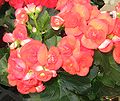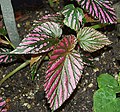Begonias
| Begonias | ||||||||||||
|---|---|---|---|---|---|---|---|---|---|---|---|---|

Tuberous begonias ( Begonia-tuberhybrida ) |
||||||||||||
| Systematics | ||||||||||||
|
||||||||||||
| Scientific name | ||||||||||||
| Begonia | ||||||||||||
| L. |
Begonias ( Begonia ), also called Schiefblatt , are a genus of plants in the family of the Schiefblattgewächse (Begoniaceae). The genus Begonia includes more than 1800 species (as of 2018), making it one of the most species-rich plant genera .
Many species and varieties of the genus Begonia ( Begonia ) are cultivated as ornamental plants in rooms or as bedding and balcony plants because of their colorful foliage or their impressive flowers .
description

Vegetative characteristics
Begonia TYPES rarely grow as annuals, usually as a perennial herbaceous plants and more rarely than half bushes to bushes that reach stature heights of only a few centimeters to 3 meters. Many species are more or less succulent . Many species form rhizomes or tubers. The stems can be erect, creeping, or drooping; sometimes they are also very short and the leaves are more or less in basal rosettes. They rarely climb with adventitious roots or form stolons .
The stipules envelop the petiole and stem . The alternate and spiral or two-line, basal or distributed on the stem arranged leaves are petiolate and often break easily. They usually have asymmetrical leaf blades, which are usually simple, rarely composed. The leaf edge can be serrated irregularly or sometimes smooth. The leaf blades are pinnate.
Generative characteristics
Begonias are single sexes ( monoecious ), so there are female and male flowers on one plant. The flowers are five-fold. The bloom cladding sheets are designed the same, so not separated into calyx and crown ( tepals ). In the male flowers there are only two or four bracts (the outer two being significantly larger than the inner) and usually many stamens . Two to five (to ten) bracts are present in the female flowers. Two to five (rarely to seven) fruit leaves are a household, under constant ovary grown.
They usually form capsule fruits , which are often asymmetrically winged and contain a large number of very small seeds. The fine seeds are spread by the wind. Some species produce berry-like fruits that are eaten by animals.
distribution
Begonia species can be found in humid tropical and subtropical regions around the world . Most of the Begonia species are native to South America. Only one species, Begonia grandis , thrives in temperate latitudes in the western hills near Beijing and is also hardy in protected areas in Central Europe.



Systematics
The generic name Begonia was published by Carl von Linné in Species Plantarum , 2, page 1056 as early as 1753 . The type species is Begonia obliqua L. The generic name Begonia honors Michel Bégon , a travel companion of the botanist Charles Plumier .
For the system of begonias see there. The species-rich genus Begonia ( Begonia ) is divided into 66 sections . There are over 1800 species of Begonia . A complete list of the approximately 1830 (as of 2018) recognized species can be found in Rafaël Govaerts (ed.): World Checklist of Selected Plant Families = WCSP.
There are separate articles for the following types:
- Eyelash begonia ( Begonia bowerae Ziesenh. ) (Section Gireoudia )
- Begonia corallina Carrière (Section Gaerdtia )
- Begonia eiromischa Ridl. (Section Ridleyella )
- Begonia microsperma Warb. (Section Loasibegonia )
- Begonia prismatocarpa Hook. (Section Loasibegonia )
- Begonia rajah Ridl. (Section Reichenheimia )
- Begonia salaziensis (Gaudich.) Warb. (Section Mezierea )
use
Varieties of some species and hybrids are used as ornamental plants in parks, gardens, balconies and rooms. For many varieties the decorative flowers are the reason for their use and for some others the interesting foliage leaves. In addition to the hybrids, varieties of the species fuchsia begonia ( Begonia fuchsioides ) and hardy begonia ( Begonia grandis subsp. Grandis ) are planted because of the flowers. The so-called "leaf begonias" include, for example: white-spotted begonia ( Begonia × albopicta = Begonia maculata × Begonia olbia ), eyelash begonia ( Begonia bowerae ), angel-wing begonia ( Begonia coccinea ), kidney begonia ( Begonia × erythrophylla = Begonia hydrocotylifolia × begonia manicata ), religious begonia ( Begonia masoniana ), metallic begonia ( Begonia incarnata Link & Otto, Syn .: Begonia metallica WGSm.), Rex begonia or royal begonia ( Begonia-Rex hybrids ).
Various groups of hybrids are widely used as ornamental plants :
- Called Begonia-Semperflorens hybrids or ice begonias,
- Elatior begonias ( Begonia × hiemalis Fotsch , Syn .: Begonia × elatior hort., Begonia-Elatior hybrids ),
- Tuberous begonias ( Begonia-tuberhybrida )
- Lorraine begonias (Lorraine begonia hybrids, Syn .: Begonia × cheimantha = Begonia dregei × Begonia socotrana ), were offered more often in the past, but can hardly be found today.
photos
Begonias used as indoor plants :
Female flowers of Begonia corallina , the yellow pistils, the bracts and the subordinate ovaries are clearly visible.
From this Begonia Hybrid has the most varieties and it is the most well-kept rooms Begonia Begonia elatior hybrids .
Leaf begonias, species that are mainly used as ornamental plants because of their decorative leaves:
Begonias that are used as bedding and balcony plants:
Overview of a bed with Begonia-Semperflorens hybrids in a park
Tuberous begonias ( Begonia-tuberhybrida )
literature
- LL Forrest, PM Hollingsworth: A recircumscription of Begonia based on nuclear ribosomal sequences. In: Plant Systematics and Evolution , Volume 241, 2003, pp. 193-211.
- Laura Lowe Forrest, Mark Hughes, Peter M. Hollingsworth: A phylogeny of Begonia using nuclear ribosomal sequence data and non-molecular characters. In: Systematic Botany , Volume 30, 2005, pp. 671-682: Online. (PDF; 481 kB)
- Shahina Ghazanfar, Parveen Aziz: Begoniaceae. : Begonia at Tropicos.org. In: Flora of Pakistan . Missouri Botanical Garden, St. Louis
- Cuizhi Gu, Ching-I Peng & Nicholas J. Turland: Begoniaceae. : Begonia , p. 153 - online with the same text as the printed work , In: Wu Zheng-yi, Peter H. Raven, Deyuan Hong (Ed.): Flora of China. Volume 13: Clusiaceae through Araliaceae , Science Press and Missouri Botanical Garden Press, Beijing and St. Louis, 2007. ISBN 978-1-930723-59-7 (section description)
Individual evidence
- ↑ Daike Tian, Yan Xiao, Yi Tong, Naifeng Fu, Qingqing Liu: Diversity and conservation of Chinese wild begonias . In: Plant Diversity . No. 40 (3) , June 2018, ISSN 2468-2659 , p. 75–90 , doi : 10.1016 / j.pld.2018.06.002 ( elsevier.com ).
- ^ Begonia at Tropicos.org. Missouri Botanical Garden, St. Louis, accessed January 20, 2015.
- ↑ a b Rafaël Govaerts (Ed.): Begonia. In: World Checklist of Selected Plant Families (WCSP) - The Board of Trustees of the Royal Botanic Gardens, Kew . Retrieved September 19, 2018.
- ^ Begonia in the Germplasm Resources Information Network (GRIN), USDA , ARS , National Genetic Resources Program. National Germplasm Resources Laboratory, Beltsville, Maryland. Retrieved January 20, 2015.
- ↑ a b c Gordon Cheers (Ed.): Botanica. The ABC of plants. 10,000 species in text and images . Könemann Verlagsgesellschaft, 2003, ISBN 3-8331-1600-5 (therein pages 135-137).
- ↑ Walter Erhardt, Erich Götz, Nils Bödeker, Siegmund Seybold: The great zander. Encyclopedia of Plant Names. Volume 2. Types and varieties. Eugen Ulmer, Stuttgart (Hohenheim) 2008, ISBN 978-3-8001-5406-7 .
Web links
- American Begonia Society . (engl.)










